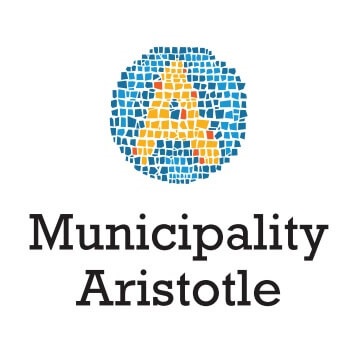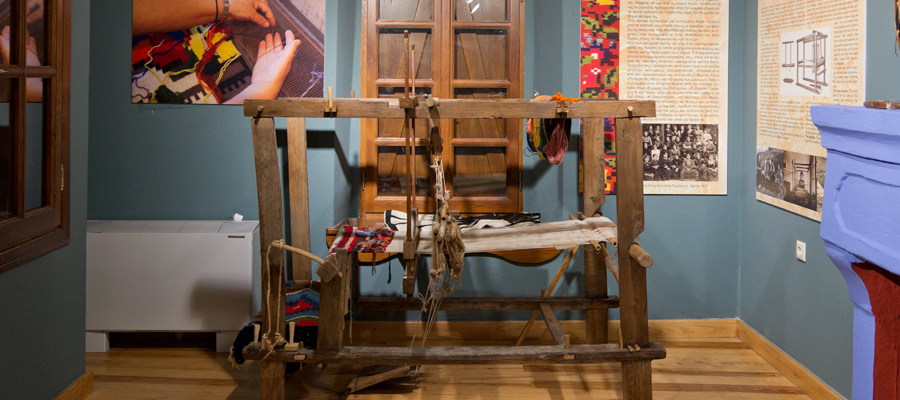The best way to immerse oneself in the art of weaving and local tradition is by visiting the Weaving Museum, which is housed in a traditional two-story building in Arnaia. It was once a private residence and is known as the Yiannoudenas house. It dates back to 1870. The building was restored and suitably modified by the Municipality to house the Weaving Museum.
ARCHITECTURE OF THE BUILDING
* This particular building is located within the densely built area of Arnaia’s residential section. It is very close to the central square of the town and across from the Historical and Folklore Museum. It is a two-story stone building, later than the “giatradiko” (doctor’s house). An internal staircase connects the ground floor with the upper floor. On the ground floor, we observe the presence of a characteristic structural element of local traditional architecture, the “sala,” at the front of the building immediately after the visitor enters. The sala replaces the “chayati” in houses built in the late 19th and early 20th centuries and serves as the space for various domestic activities.
THE ART OF WEAVING
* Weaving has been one of the most important occupations of the inhabitants of Arnaia until recently, and it was closely connected to their lives. The artistic value of the products made Arnaia known as a center for weaving art throughout Greece. Therefore, the establishment of a space to showcase the works of the city’s female weavers was deemed necessary.
The history of Arnaia’s handmade carpets goes back in time: classic geometric patterns such as “krikela,” “scissors sun,” and other techniques recorded in the rest of Macedonia and Thrace, such as “thilota” and “with the nail,” dominate the colorful spaces.
The main design is the “calligraphic” Arnaian carpets, which were and still are (mostly) used for wall decoration. In most of them, the creation date and the weaver’s initials are woven into the edges. The themes originate from designs for counted cross-stitch embroidery. They are influenced by Neoclassicism and depict representations such as “the chariot of Eos,” “the dance of the Muses,” as well as historical themes from modern Greece (“the dance of Zalongo”), daily life (“the shepherdess”), and more.
THE EXHIBITION SPACE
At the Weaving Museum, there are various weaving tools and objects, such as the loom or the spindle, as well as numerous woven items that reveal a treasure of local tradition through their rich themes, techniques (such as “thilota” and “with the nail”), and colors. Most of the museum’s exhibits are donations from the personal collection of Charikleia Dimitrakoudi, a renowned weaver and merchant, and one of the most important representatives of the country’s female weavers, who worked passionately and diligently to keep the tradition alive and significantly promoted the dissemination of local cultural traditions.
The exhibition’s concept was based on the idea of creating a museum space that respects the past and the existing materials. Its organization aims to present the visitor with an unknown treasure of our local tradition, a comprehensive picture of the wool processing process, and the creation of woven items while simultaneously transporting them to another era. The Weaving Museum boasts a unique collection of exhibits that impress visitors with their abundance of themes, colors, and techniques without overwhelming them.
The space is developed on two levels:
On the ground floor, visitors can observe step by step the process of transforming raw wool into thread ready for the loom and weaving. These successive tasks, placed in chronological order, are as follows: washing the wool, carding the wool, spinning with the distaff and spindle, and weaving. Objects and tools related to this process, as well as woven items, are presented in thematic units and displayed in showcases. Also on display are personal items of Charikleia Dimitrakoudi, such as her glasses, threads, dyes she used, and dye recipes—priceless items for the museum’s collection.
The upper floor is dedicated to the exhibition of the products of weaving art as a whole, such as “calligraphic” carpets, which were used as wall decorations, woven items used in the home, and clothing items. Their themes are varied, including “The Dance of the Muses,” “The Dance of Zalongo,” “The Shepherdess,” “The Heroic Spirit,” “The Honeymoon Month.” On the same floor, visitors can see up close how a room in traditional local houses was arranged in the past and learn about the most common forms of woven items that adorned the homes of Arnaia.
Texts by archaeologist Athina Marathianou.
Info
The exhibition also includes related audiovisual material. Information at: +30 23723 51100



